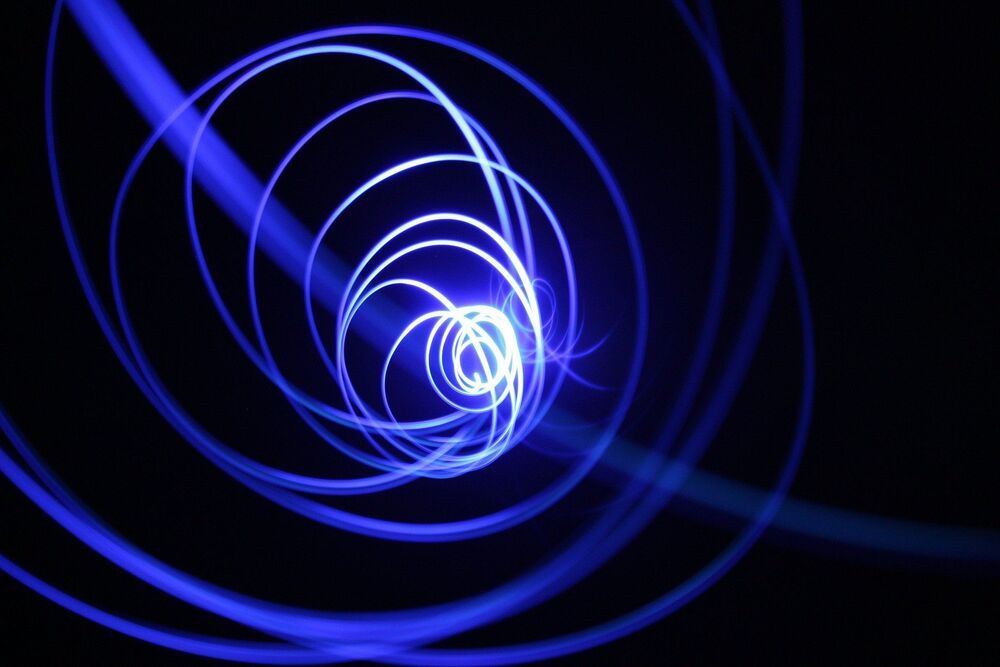I never thought about it, but these 3D magic eyes also work on computers.



On the path to writing his Ph.D. dissertation, Lucio Milanese made a discovery—one that refocused his research, and will now likely dominate his thesis.
Milanese studies plasma, a gas-like flow of ions and electrons that comprises 99 percent of the visible universe, including the Earth’s ionosphere, interstellar space, the solar wind, and the environment of stars. Plasmas, like other fluids, are often found in a turbulent state characterized by chaotic, unpredictable motion, providing multiple challenges to researchers who seek to understand the cosmic universe or hope to harness burning plasmas for fusion energy.
Milanese is interested in what physicist Richard Feynman called “the most important unsolved problem of classical physics”—turbulence. In this case, the focus is plasma turbulence, its nature and structure.

A team of researchers at Columbia University has developed a way to allow DNA strands to store more data. In their study, published in the journal Science, the group applied a small amount of electricity to DNA strands to allow for encoding more information than was possible with other methods.
For several years, researchers have been looking for ways to increase data storage capacity—storage requirements are expected to exceed capacity in the near future as demand skyrockets. One such approach has involved encoding data into strands of DNA—prior research has shown that it is possible. In the early stages of such research, scientists manually edited strands to add characteristics to represent zeroes or ones. More recently, researchers have used the CRISPR gene editing tool. Most such studies used DNA extracted from the tissue of deceased animals. More recently, researchers have begun efforts to move the research to living animals because it will last longer. And not just in the edited strands—the information they contain could conceivably be passed on to offspring, allowing data to be stored for very long periods of time.
Back in 2017, another team at Columbia University used CRISPR to detect a certain signal—in their case, it was the presence of sugar molecules. Adding such molecules resulted in gene expressions of plasmid DNA. Over time, the editing process was improved as genetic bits were added to represent ones and zeroes. Unfortunately, the system only allowed for storing a few bits of data.

Researchers at Columbia Engineering report today that they have developed the first nanomaterial that demonstrates “photon avalanching,” a process that is unrivaled in its combination of extreme nonlinear optical behavior and efficiency. The realization of photon avalanching in nanoparticle form opens up a host of sought-after applications, from real-time super-resolution optical microscopy, precise temperature and environmental sensing, and infrared light detection, to optical analog-to-digital conversion and quantum sensing.
“Nobody has seen avalanching behavior like this in nanomaterials before,” said James Schuck, associate professor of mechanical engineering, who led the study published today by Nature. “We studied these new nanoparticles at the single-nanoparticle level, allowing us to prove that avalanching behavior can occur in nanomaterials. This exquisite sensitivity could be incredibly transformative. For instance, imagine if we could sense changes in our chemical surroundings, like variations in or the actual presence of molecular species. We might even be able to detect coronavirus and other diseases.”
Avalanching processes—where a cascade of events is triggered by series of small perturbations—are found in a wide range of phenomena beyond snow slides, including the popping of champagne bubbles, nuclear explosions, lasing, neuronal networking, and even financial crises. Avalanching is an extreme example of a nonlinear process, in which a change in input or excitation leads to a disproportionate—often disproportionately large—change in output signal. Large volumes of material are usually required for the efficient generation of nonlinear optical signals, and this had also been the case for photon avalanching, until now.
Over the past decade or so, deep neural networks have achieved very promising results on a variety of tasks, including image recognition tasks. Despite their advantages, these networks are very complex and sophisticated, which makes interpreting what they learned and determining the processes behind their predictions difficult or sometimes impossible. This lack of interpretability makes deep neural networks somewhat untrustworthy and unreliable.
Researchers from the Prediction Analysis Lab at Duke University, led by Professor Cynthia Rudin, have recently devised a technique that could improve the interpretability of deep neural networks. This approach, called concept whitening (CW), was first introduced in a paper published in Nature Machine Intelligence.
“Rather than conducting a post hoc analysis to see inside the hidden layers of NNs, we directly alter the NN to disentangle the latent space so that the axes are aligned with known concepts,” Zhi Chen, one of the researchers who carried out the study, told Tech Xplore. “Such disentanglement can provide us with a much clearer understanding of how the network gradually learns concepts over layers. It also focuses all the information about one concept (e.g., “lamp,” “bed,” or “person”) to go through only one neuron; this is what is meant by disentanglement.”
On 14 November 2014, a bright flash flagged the All Sky Automated Survey for Supernovae, or ASAS-SN — a global network of 20 telescopes managed at Ohio State University in the U.S. The flash originated in galaxy ESO 253–3, located 570 million light-years away.
The sudden burst of energy was examined by astronomers and categorized as a likely supernova and assigned the event designation ASASSN-14ko. Six years later, Anna Payne, a NASA Graduate Fellow at the University of Hawai’i at Mānoa, discovered it was something much different.
While sifting through ASAS-SN data on active galactic nuclei, she discovered a previously unnoticed periodic series of bright flares emanating from galaxy ESO 253–3 — repeating in such a way that led directly back to ASASSN-14ko as the point of first detection.

“This is perhaps the hardest part of all DNA storage approaches. If you can get the cells to directly talk to a computer, and interface its DNA-based memory system with a silicon-based memory system, then there are lots of possibilities in the future.”
The work builds on a CRISPR-based cellular recorder Wang had previously designed for E. coli bacteria, which detects the presence of certain DNA sequences inside the cell and records this signal into the organism’s genome.
The system includes a DNA-based “sensing module” that produces elevated levels of a “trigger sequence” in response to specific biological signals. These sequences are incorporated into the recorder’s “DNA ticker tape” to document the signal.

Meet the “Yangtze River Three Gorges 1”, an electric cruise ship, announced in December, that is poised to become the world’s largest of its kind (among EVs).
According to the brief info, it will be launched in July and enter service in November of 2021, on popular tourist routes: the Two Dams and One Gorge, the Yichang Yangtze River Night Cruise, and the Three Gorges Shiplift.
Not only will the size and passenger capacity be the highest, but also the battery capacity — roughly 7.5 MWh (an equivalent of 75–100 long-range electric cars). The LFP-type batteries (over 10000 cells) will be supplied by CATL.
